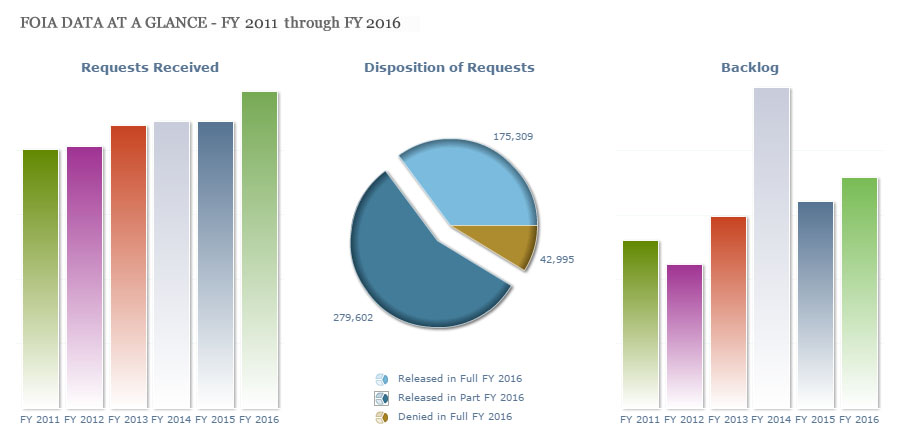

Federal Freedom of Information Act offices saw a record number of information requests in fiscal 2016, an accomplishment that highlights the need to be able to...
The Justice Department’s Office of Information Policy is offering agencies a Freedom of Information Act toolkit, a resource for self-assessments that officials hope will improve government transparency after a record year of information requests.
OIP Director Melanie Pustay said the toolkit will be available later in 2017, and is part of DOJ’s overarching Open Government Plan to “move the ball forward” and help Justice components with their transparency and FOIA mission.
“It’s a project that we’re working on and the idea is to help guide agencies in conducting self-assessments,” Pustay said March 13, at DOJ’s Sunshine Week kickoff event in Washington, D.C. “So we took all the major topical areas of FOIA administration and created questions and analysis for agencies to walk through to see if those particular areas are operating efficiently and effectively; like a way to help the agency look critically at how it’s doing intake, how it’s doing consultations, how it’s doing customer service, so it has some structure to it.”
Pustay couldn’t offer a hard date on the toolkit’s release, but she said it would be organized into modules, so that FOIA offices can decide which areas they want to look at and self-asses. Those modules will include areas like mail intake, website development, customer service and FOIA reporting.
The toolkit will be for the people running FOIA offices, Pustay added, the “heart and soul of FOIA.”
Agencies’ performance in fulfilling FOIA inquiries is of particular interest to media and the public, as requests for information have soared at some agencies since President Donald Trump took office.
Rachel Dowell, assistant counsel at the Office of Government Ethics, said during the kickoff event that her agency had seen a 200 percent increase in volume of requests from fiscal 2016.
Notably in early February, OGE found itself in what website administrator Michael Hanson said was a “Best Buy on Black Friday,” situation, after Trump adivser Kellyanne Conway commented on Ivanka Trump’s clothing line.
1/OGE’s website, phone system and email system are receiving an extraordinary volume of contacts from citizens about recent events.
— U.S. OGE (@OfficeGovEthics) February 9, 2017
“Our website never crashed,” Hanson said. “The store was full of people, line out the door, down the street, around the corner. We just couldn’t service the amount of traffic. For us it was strictly a horsepower problem, it wasn’t a configuration issue, nothing nefarious, nothing out of the ordinary other than we were real popular.”
Hanson said OGE has about $600,000 in discretionary spending outside of rent and payroll, so there is only so much the agency can pay to do. That being said, OGE has moved some of its documents that it knows are going to be popular — such as the ongoing dialogue between OGE and the White House about Conway’s comments — to a cloud storage company, Box.com, Hanson said.
That way, Hanson said, when OGE posts document links on its Twitter feed, the traffic is diverted to a cloud provider that can handle that kind of traffic.
DOJ Chief Technology Officer Ron Bewtra said a lot of problems he and his colleagues are starting to see is how to bring the latest technology into the FOIA community.
“We need to focus on what are the requirements that we have, who are our customers, both internally as our stakeholders and really the citizens, and also all those policies and governance that really go along with it,” Bewtra said.
In reference to something like the high volume of traffic at OGE, Bewtra also said that people “aren’t preparing for an explosion, and we’ve got to start thinking about how we can help each other.”
“That will take a little bit of time,” he said. “Understanding what those core requirements are, understanding if we have standard metadata. Let’s say that you’ve made a fast transition from small to medium to large. Those transitions are actually difficult because you’ve got to make hard decisions, and you’re going to bring in really solid technologists to help make those things happen. We’re not as a technical community helping the overall FOIA community make that easy. Those are types of standards that we can help, and then when these things happen, we can help faster transition to bigger tools.”
Fiscal 2016 was also a standout year for FOIA requests. Recently released information on fiscal 2016 on FOIA.gov show that governmentwide, more than 788,000 requests were received, compared to the roughly 713,000 requests in 2015.

“Just a tremendous and constant increase in incoming requests,” Pustay said. “While on the one hand it clearly poses a challenge to all of us inside agencies to handle and meet this demand, the other side of it is that it’s a tremendous validation of the importance and the validity and the popularity of the Freedom of Information Act, and the fact it is used so extensively in our country, is ultimately something we can be very proud of.”
More than 50 percent of the requests were released in part, while roughly 35 percent were released in full. Less than 9 percent of the requests were denied in full.
The total FOIA backlog rose between 2015 and 2016, from about 102,000 requests to 115,000 requests.
Pustay said agency FOIA offices are also scheduled to post their chief FOIA officer reports, which is a narrative complement to the annual FOIA report.
“These detail all the different initiatives and efforts that agencies have taken over the past year to make improvements in their FOIA operations,” Pustay said. “So in the face of this ongoing increased demand and increasingly complex requests, agencies are continuing to take steps to improve their programs, they’re looking for tools and technological approaches to achieve greater efficiencies, they’re conducting outreach and actively working with the requestor community, they’re identifying ways to proactively release information and make improvements to how that information is presented to the public.”
Copyright © 2024 Federal News Network. All rights reserved. This website is not intended for users located within the European Economic Area.

